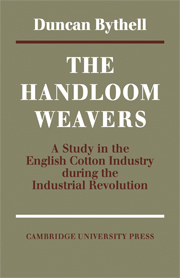Book contents
- Frontmatter
- Contents
- Preface
- Introduction
- Map of the weaving towns and villages of north-east Lancashire in 1821
- 1 Problems and sources
- 2 The organization of the industry
- 3 The labour force
- 4 The coming of the powerloom
- 5 Wages: (I) The piece-rate
- 6 Wages: (II) Earnings and the standard of living
- 7 Public opinion and the handloom weavers
- 8 Organized industrial action among the cotton handloom weavers
- 9 The weavers and radical politics
- 10 The problem of poverty
- 11 Displacement and disappearance
- Appendix 1 Some piece-rate series
- Appendix 2 The piece-rate and the price of food
- Appendix 3 G. H. Wood's estimates of average weekly earnings
- Bibliography
- Index
- Frontmatter
- Contents
- Preface
- Introduction
- Map of the weaving towns and villages of north-east Lancashire in 1821
- 1 Problems and sources
- 2 The organization of the industry
- 3 The labour force
- 4 The coming of the powerloom
- 5 Wages: (I) The piece-rate
- 6 Wages: (II) Earnings and the standard of living
- 7 Public opinion and the handloom weavers
- 8 Organized industrial action among the cotton handloom weavers
- 9 The weavers and radical politics
- 10 The problem of poverty
- 11 Displacement and disappearance
- Appendix 1 Some piece-rate series
- Appendix 2 The piece-rate and the price of food
- Appendix 3 G. H. Wood's estimates of average weekly earnings
- Bibliography
- Index
Summary
At one time, the story of the English cotton industry held pride of place in accounts of those many social and economic changes which are conventionally labelled ‘the industrial revolution’, and it is not difficult to understand why. Cotton was, after all, the first major industry to use power-driven machinery in factories; contemporary observers tended to be particularly impressed because its growth in the late eighteenth and early nineteenth centuries was on a far bigger scale than that of the traditional woollen, silk, and linen textiles; and most important of all, cotton's interests became very closely involved in national politics in the 1830s and 1840s. To a very large degree, the controversies over factory regulation and free trade concerned cotton more than any other industry, since, in the popular imagination at least, ‘factories’ meant cotton mills, and ‘free traders’ meant Lancashire millowners. From the crucial importance of these controversies to the development of the new urban-industrial society, it necessarily followed that the cotton trade should come to be widely regarded as the centre-piece of the new order.
More recently, however, the emphasis in industrial revolution studies has changed, and the cotton industry has been dethroned from the position it formerly occupied. This has come about largely through the study of the more basic general developments in transport, in power supplies, in the making of capital goods, and in capital formation—all of which can be termed the sine qua non of industrial growth.
- Type
- Chapter
- Information
- The Handloom Weavers , pp. 1 - 24Publisher: Cambridge University PressPrint publication year: 1969



